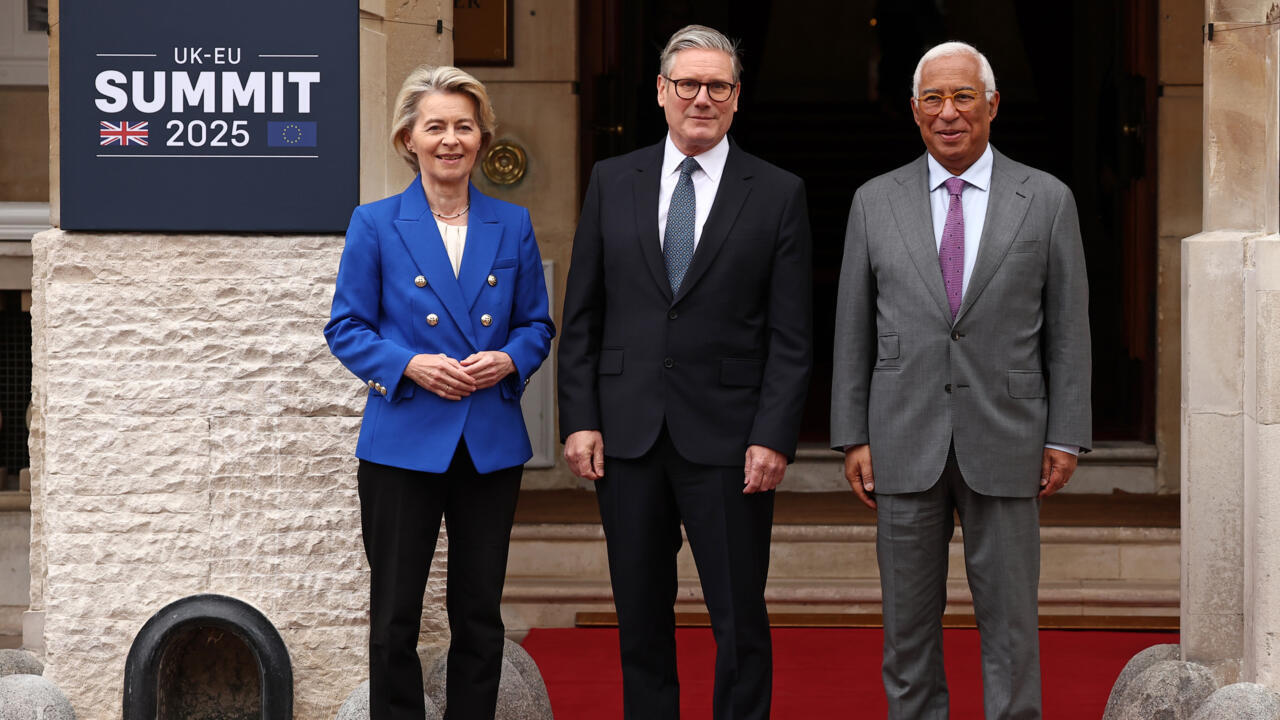After reaching a consensus in their tariff negotiations in Geneva, China and the United States have significantly reduced their duties on each other. This has awakened countries around the world and inspired them to launch a new wave of regional integration.

UK Prime Minister Keir Starmer is hosting EU Commission President Ursula von der Leyen and European Council President Antonio Costa in London.(Photo: Henry Nicholls/AFP)
The tariff war launched by Donald Trump in his second term has not only had a severe impact on the global economy but has also prompted countries around the world to reflect on the potential direction of international relations. After reaching consensus in their negotiations in Geneva, China and the United States significantly reduced their tariffs on each other, and this, in turn, has accelerated a strategic awakening worldwide.
Regional reintegration across Asia and Europe is unfolding. On May 19, leaders of the European Union and United Kingdom met in London for their first summit since Brexit in 2020. Their joint statement affirmed their “mutual commitment to free, sustainable, fair and open trade” and said they “remain committed to the goals of the Paris agreement.”
The two sides also signed an agreement on food trade and set up foreign and security policy dialogues between their defense secretaries to be held every six months. This effectively marks the end of the UK’s opposition, under the Conservative Party, to participation in European integration and signaled its renewed involvement in the process.
On the same day, Indonesia and Thailand announced that they would upgrade their relationship to a strategic partnership. They agreed to establish a consultation committee to expand bilateral trade and investment and strengthen cooperation in the green and digital economies. In ASEAN, Indonesia and Thailand are is the top two economies, with their combined GDP accounting for more than half the region’s total. The elevation of their ties to a strategic partnership is expected to drive the integration process within ASEAN. Only a few days ago, Thailand and Vietnam established a comprehensive strategic partnership, and Indonesia’s relations with Vietnam have been upgraded.
The catalyst for this new wave of regional integration is Trump’s tariff war, but its lasting driving force is a pragmatism inspired by major shifts in international relations. Trump’s tariffs on ASEAN countries are notably high — 32 percent on Indonesia and 36 percent on Thailand, for instance — propelling them to find a way out through deeper regional cooperation.
For Washington’s allies, the impact of Trump’s unilateral tariffs may be even more severe. Alliances are built on a sense of certainty, and an unpredictable United States prone to sudden policy changes may force its allies to see their U.S. alliances less as an asset and more of a risk. They will have to find new certainties to “de-risk” their relations with the United States.
For example, Japan is now promoting the Comprehensive and Progressive Agreement for Trans-Pacific Partnership, and its parliament is discussing a resolution supporting the global free trade system. With South Korea’s presidential election approaching, the next administration there is expected to pursue a foreign policy grounded more in pragmatism than ideology. For both Seul and Tokyo, postwar economic development has been rooted in the WTO-centered multilateral trading system, and their return to pragmatic diplomacy suggests that regional integration in Northeast Asia will gain momentum.
Last year, the China-Japan-ROK summit was resumed in South Korea. It is scheduled to be held in Japan this year and in China next year. This restart of trilateral cooperation will contribute to the success of the China-ASEAN Free Trade Area 3.0, which aims to create a regional market with a population of 2 billion people. It will also stabilize the global economy, where the market itself is a scarce resource.
Cross-regional integration will improve the world economy’s balance and stability. Trump once warned BRICS countries that if they tried to replace the U.S. dollar, they would be hit with extremely high tariffs. Ironically, his threat reminded these countries that they are in fact not that dependent on the United States. Together, they account for half the world's population and 40 percent of global GDP.
Today, they are working to strengthen local currency transactions with each other. In May, Brazil’s President Luiz Inacio Lula da Silva, Colombia’s President Gustavo Petro and Chile’s President Gabriel Boric showed up in Beijing for the fourth ministerial meeting of the China-CELAC Forum (Community of Latin American and Caribbean States).
The development of China’s economic relations with Latin American countries has also indirectly promoted economic integration within the region. For example, the Chinese company Mixue Ice Cream & Tea, now the world’s largest restaurant chain, has pledged to invest four billion yuan ($556 billion) to purchase materials from Brazil. Since Brazil’s exports to East Asia rely on ports on the Pacific coast, the announcement motivated other countries in the region to pursue the interconnection of transportation infrastructure. At the same time, the long-delayed free trade agreement between the Southern Common Market and the European Union is back on the agenda.
This year marks the 80th anniversary of the end of World War II and the founding of the United Nations. As an important component of the UN system, the World Trade Organization aims to provide a predictable and fair multilateral trading system, as required by its founding principles. Although it has been largely dysfunctional in recent years, the majority of international trade still relies its agreements. Ultimately, the wave of regional reintegration triggered by Trump’s tariff war will help revive global free trade.
